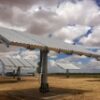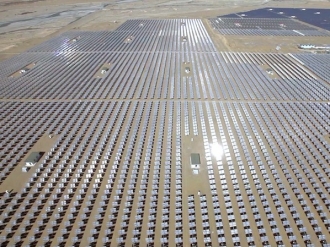IHS, January 8th, 2015
While 2014 remained a challenging time for the solar photovoltaic (PV) industry, it marked an inflection point in the market’s development. According to a new white paper issued by the IHS Solar service at information and analytics provider IHS (NYSE: IHS), solar PV demand grew at a double-digit pace, largely due to policies in China and Japan; yet conditions remained extremely tough for suppliers.
Through mergers, acquisitions and bankruptcies, the supplier base consolidated further, as companies struggled with debt-laden balance sheets and a rapid shift in their customer base away from their traditional markets,” said Ash Sharma, senior research director for solar at IHS. “All signs point to a strengthening recovery of the solar industry in 2015, even if the recovery itself remains incredibly fragile.”
Following are the top 10 predictions for 2015 from the IHS solar research team:
1. Global solar PV demand is forecast to grow by up to 25 percent in 2015. Due to the ongoing cost reductions for solar PV, IHS forecasts that installation demand will grow at a double-digit rate of 16 to 25 percent and installations in the range of 53 to 57 gigawatts (GW). Geographically, the largest markets again will be China, Japan and the United States, while the largest contributors in terms of absolute growth will be China, the United States and India.
2. Concentrated Photovoltaic Solar (CPV) to experience accelerated growth. Starting in 2015, IHS forecasts an accelerated CPV market expansion of 37 percent, to reach approximately 250 megawatts (MW) of new installations. Installations of both high-concentration photovoltaic (HCPV) and low-concentration photovoltaic (LCPV) systems will expand at double-digit percentages every year through 2020.
3. Distributed PV (DPV) in China to fall behind expectations, but continues to grow. With challenges ahead for China’s ambitious plans for DPV, IHS forecasts the country will struggle to achieve it aggressive targets. Even so, the market is clearly beginning to build momentum, and policies and business models are helping to accelerate growth. IHS forecasts that DPV installations in China will reach 4.7 GW in 2015, an increase of nearly 20 percent from 2014.
4. Grid-connected PV energy storage installations to triple. The PV power system is evolving away from the traditional and relatively simple system of one-directional flow—from large-scale conventional generators through transmission and distribution lines to consumers, to an increasingly complex mix of small, distributed generators and consumers at all points in the electricity grid. Annual installations of grid-connected PV systems, paired with energy storage, will grow more than threefold, to reach 775 MW in 2015.
5. Emerging markets mature – Chile will follow South Africa to reach 1 GW of installed PV capacity. IHS forecasts that Chile will be the next emerging market, after South Africa, to reach the milestone of 1 GW in installed PV solar capacity. Aside from Chile, other new emerging markets poised for rapid growth in 2015 are Jordan, the Philippines and Honduras. Conversely, great uncertainty still surrounds Mexico, Brazil and Turkey.
6. Monocrystalline technology to increase market share. Although monocrystalline technology will not threaten multicrystalline domination in the near future, IHS expects it will steadily gain share, benefiting from growth on rooftop installations, as well as increasing demand for higher-efficiency products. IHS forecasts the monocrystalline share of global cell production will increase to 27 percent in 2015, up from 24 percent in 2014.
7. Systems up to 100 kilowatts to account for 30 percent of global installations. There is potential in store for DPV in both established and emerging markets around the world. IHS forecasts distributed photovoltaic (DPV) systems—i.e., those sized 100 kilowatts (kW) or smaller—to account for 30 percent of global installations in 2015, with 15.7 GW projected, up from 13.2 GW in 2014. The largest market for these installations in 2015 will be Japan, with DPV accounting for nearly 70 percent of installations. The U.S. is also expected to install more than 2.2 GW of DPV in 2015, as net-metering and third-party ownership models continue to drive this market.
8. Second quarter (Q2) halt to U.K. utility-scale PV to trigger new wave of consolidation among EuropeanEngineering, Procurement and Construction (EPC) contractors. The clock is running down for integrators of large-sized solar systems in Europe, with the expiration of a U.K. incentive program bringing an end to a boom in utility-scale installations and triggering a flurry of consolidation. The U.K. in 2015 will dominate the utility-scale PV landscape in Europe by installing 1.4 GW of ground-mount systems, primarily under the renewable obligation certificates (ROC) scheme.
9. Three-phase string inverters to account for one-third of global solar inverter revenue. Driven by attractive prices in key PV markets, global revenue for three-phase string inverters is forecast in 2015, to reach more than $2.2 billion, equivalent to one-third of worldwide revenue for the overall market for inverters. Estimated shipments next year of three-phase string inverters will exceed 15 GW, up 31 percent from 2014. A surge is expected in important markets like China and Japan, whose combined shipments will account for 7.6 GW of the total.
10. California in 2015 will become global leader in solar power penetration. IHS expects that by the end of 2015, California—the largest renewable power market in the United States—will attain worldwide leadership in market share of annual power generation received from solar PV. Following another year of strong utility-scale and DPV additions, solar power is expected to provide more than 10 percent of California’s annual power generation in 2015. This penetration level would push California above other leading global solar markets, such as Germany and Italy, in terms of the share of total power generation sourced from solar PV.












